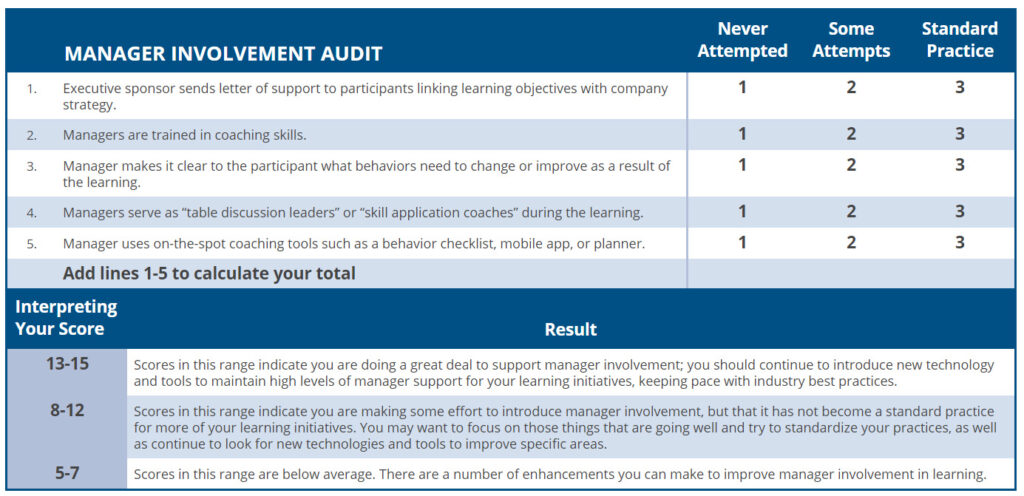1. Equip Managers with Coaching Skills
Regardless of the training’s focus, equipping participants’ managers with a structured, methodical approach for learning coaching skills—something as straightforward as an easy-to-remember coaching process—greatly increases the likelihood of managers providing coaching that recognizes, reinforces, and/or redirects desired behaviors.
Our research shows that after training the managers in coaching skills, the average performance improvement of direct reports is 18%. Not bad—18%. However, when you compare that to studies in which you train managers in both general coaching skills and how to coach to the specific skills their employees are learning, you get a different picture. Performance improves 42%—or two and a half times more than with coaching skills alone. This brings us to our next point.
2. Enlighten Managers with Knowledge of What Learners Are Learning
A great example of a highly effective coach is James (Doc) Counsilman—a former college swim coach with the best win record in history. Yes, he had great coaching skills, but what set him apart was his knowledge of swimming; he studied, researched, and wrote about swimming.
While not every coach needs the depth of a Doc Counsilman, every effective coach needs to understand the skills he or she is coaching to. Unfortunately, in today’s fast-paced and busy work world, we often act as if a “quick overview” of the skills is enough to prepare managers to coach effectively.
Of course, the best case scenario is providing the very opportunity for managers to participate in the learning experience along with their direct reports. That being said, if time, place, or practicality doesn’t allow for managers to complete the very same training, there are several other ways to enlighten and involve busy managers.
Consider the spectrum of engaging options for involving managers:
- Concise e-learning modules delivered to managers’ desktops, taken when and where they are able.
- Training content embedded into the coaching skills development program.
- A hands-on role at a learning workshop in which managers act as “table discussion leaders” during skill practice and application exercises.
- A front-of-the room role at a learning session in which managers act as a co-facilitator and assist the professional facilitator, especially in the area of guiding and debriefing application exercises.
- A thorough program overview delivered face-to-face or via webcast, conference call, or video, at a minimum.
3. Enable Managers with Accessible, Timely Coaching Tips and Tools
The number one reason managers give for not coaching more is, “I don’t have the time!” Being ever mindful of the time crunch faced by overloaded managers, as well as providing tips and tools that solve these time crunches, can boost the amount and effectiveness of their coaching.
Best practices we have learned from organizations to address time issues include:
- Provide managers with “coaching sessions in a box” playbooks that include everything from e-mail invitations to scripts, key coaching questions, and worksheets. This way, managers do not have to create the coaching activity; they just have to deliver it.
- Focus managers on frequent, short coaching conversations rather than long coaching sessions. It is easier for a manager to find time to coach six employees for 10 minutes each rather than find time for a 60-minute coaching session.
- Push out weekly reminders to coach—make coaching not something they do, but who they are.
- Provide video models of short coaching conversations; a major reason managers hold back from coaching is the fear they will do it incorrectly. Modeling videos help overcome that fear.
Consider the message and the media. Send the right message at the right time. Keep content chunks small, digestible, and actionable. Provide easy access to planners, behavior checklists, mobile apps, and other tools.
Assessing Managerial Involvement
So, are your managers prepared for this critical role?



